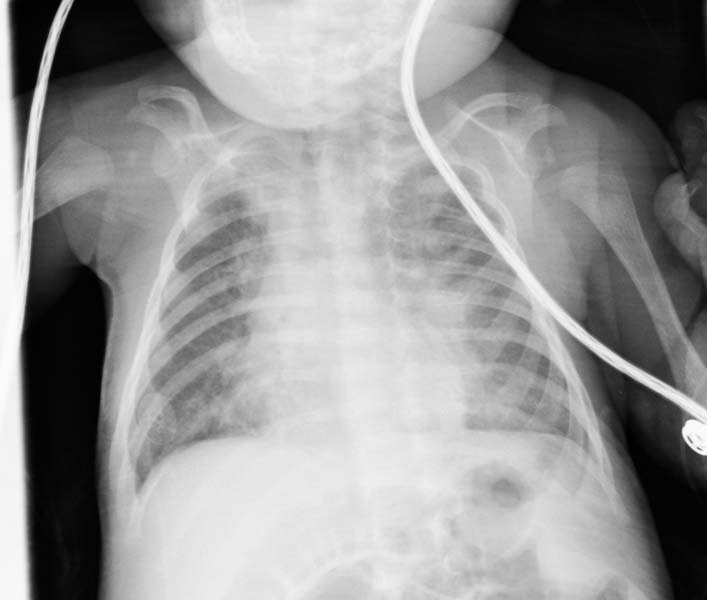WBR0530: Difference between revisions
Jump to navigation
Jump to search
No edit summary |
m (refreshing WBR questions) |
||
| Line 1: | Line 1: | ||
{{WBRQuestion | {{WBRQuestion | ||
|QuestionAuthor=Vendhan Ramanujam | |QuestionAuthor=Vendhan Ramanujam | ||
|ExamType=USMLE Step 2 CK | |ExamType=USMLE Step 2 CK | ||
Latest revision as of 00:52, 28 October 2020
| Author | PageAuthor::Vendhan Ramanujam |
|---|---|
| Exam Type | ExamType::USMLE Step 2 CK |
| Main Category | MainCategory::Pediatrics |
| Sub Category | SubCategory::Respiratory |
| Prompt | [[Prompt::During winter, a previously well 1 year old infant is brought to the emergency room by his mother with complaints of cough and difficulty in breathing. He has been having a runny nose along with sneezing and coughing for the past two days. His elder sibling had similar complaints last week. Four hours ago, the patient’s cough started becoming worse. On physical examination, he is in moderate respiratory distress with nasal flaring, hyperexpansion of the chest is seen, and easily audible wheezing without rales are heard. His vital signs are heart rate 140 beats/min, respiratory rate 64/minute, blood pressure 100/60 mm Hg, oral temperature 38 C. A chest X ray was taken and it is shown below |
| Answer A | AnswerA::Diphtheria |
| Answer A Explanation | [[AnswerAExp::Incorrect-Diphtheria is not a reasonable choice because of the absence of extrathoracic airway obstruction (stridor). Diphtheria usually presents with specific signs like stridor, tonsil and soft palate swelling, and swollen neck lymph nodes.]] |
| Answer B | AnswerB::Viral croup |
| Answer B Explanation | [[AnswerBExp::Incorrect-Viral croup is not a reasonable choice because of the absence of extrathoracic airway obstruction (stridor). Viral croup will usually manifest with a harsh barking cough and hoarse voice.]] |
| Answer C | AnswerC::Bronchiolitis |
| Answer C Explanation | [[AnswerCExp::Correct-The family history of upper respiratory infections, the previous upper respiratory illness in the patient, and the signs of intrathoracic airway obstruction (hyperexpansion of chest and audible wheeze without rales) along with fever and mild tachypnea makes the diagnosis of bronchiolitis more likely.]] |
| Answer D | AnswerD::Epiglottitis |
| Answer D Explanation | [[AnswerDExp::Incorrect- Epiglottitis is not a reasonable choice because of the absence of extrathoracic airway obstruction (stridor). Epiglottitis will manifest as acute onset of high fever, toxemia and noisy breathing (low pitched inspiratory stridor accompanied by expiratory snore). Cough will be usually absent.]] |
| Answer E | AnswerE::Asthma |
| Answer E Explanation | AnswerEExp::'''Incorrect'''-Although asthma can have a similar presentation, the history will favor a diagnosis of bronchiolitis. |
| Right Answer | RightAnswer::C |
| Explanation | [[Explanation::Among the choices given, bronchiolitis is the most likely cause. The family history of upper respiratory infections, the previous upper respiratory illness in the patient, and the signs of intrathoracic airway obstruction (hyperexpansion of chest and audible wheeze without rales) along with fever and mild tachypnea makes the diagnosis of bronchiolitis more likely. Asthma, pertussis, and bronchopneumonia can also have a similar presentation. The most likely cause of the illness is infection by respiratory syncytial virus, which causes outbreaks of bronchiolitis of varying severity, usually in the winter and spring. Other viruses, such as parainfluenza and the adenoviruses, have also been implicated in producing bronchiolitis.
Educational Objective:
A family history of upper respiratory infections, previous upper respiratory illness, and the signs of intrathoracic airway obstruction (hyperexpansion of chest and audible wheeze without rales) along with fever and mild tachypnea can make the diagnosis of bronchiolitis more likely during winter and spring. Asthma, pertussis, and bronchopneumonia can also have a similar presentation. |
| Approved | Approved::Yes |
| Keyword | WBRKeyword::Bronchiolitis, WBRKeyword::Asthma, WBRKeyword::Epiglottitis, WBRKeyword::Viral croup, WBRKeyword::Diphtheria |
| Linked Question | Linked:: |
| Order in Linked Questions | LinkedOrder:: |
